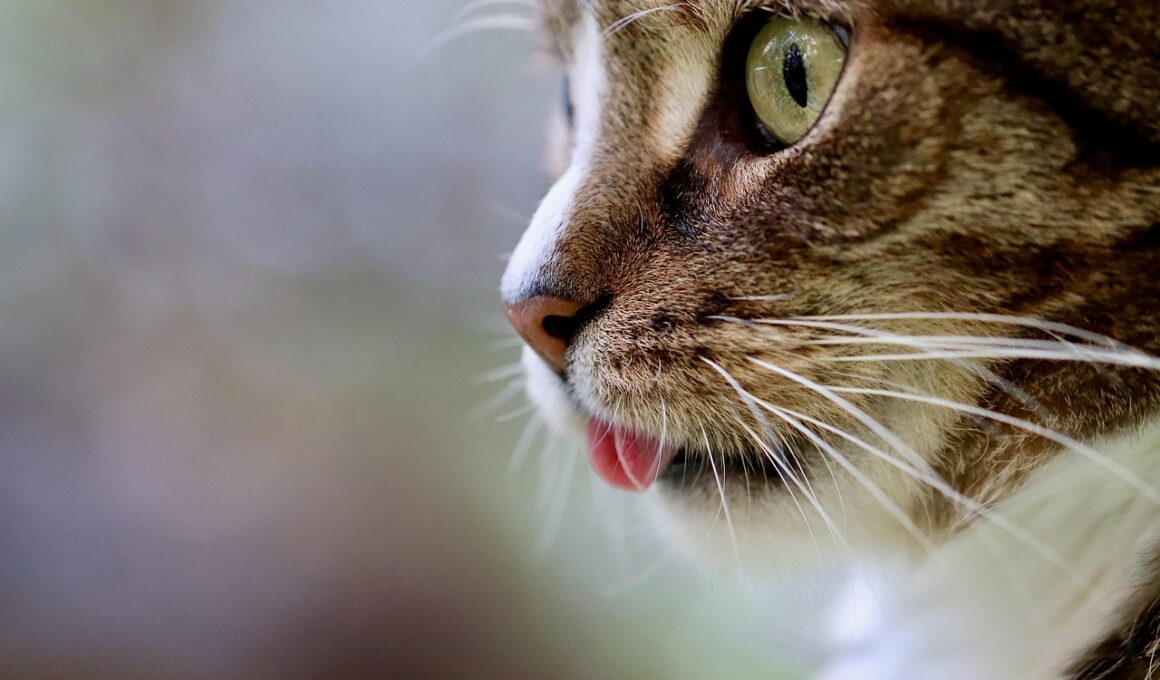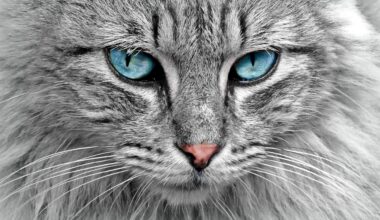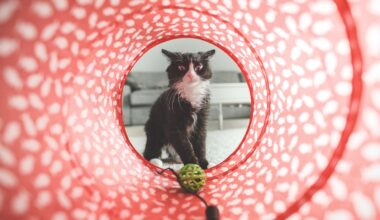The Effects of Climate on Cat Hydration and Vitamin Uptake
Understanding how climate influences hydration and vitamin absorption in cats is crucial for pet owners. The environment in which a cat lives can significantly affect its health and hydration levels. Cats are known for their unique drinking behaviors, often relying heavily on moisture from their food. Still, when temperatures rise, their hydration requirements tend to increase. Higher temperatures can lead to dehydration, making fresh water essential in their diet. It’s important to provide enough access to clean, fresh water to encourage proper hydration. Dry or hot climates can exacerbate dehydration, especially if a cat is primarily on a dry food diet. While cats can adapt to their surroundings, awareness of their hydration needs is vital during hot summer months. Additionally, optimal hydration plays a crucial role in the body’s ability to absorb vitamins effectively. The body’s absorption of vitamins can be hindered without adequate hydration, leading to potential deficiencies. Ensuring that your cat stays properly hydrated promotes not only their overall health but also their ability to absorb essential vitamins. Always monitor your cat’s drinking habits and consult a veterinarian for tailored hydration advice.
Factors such as humidity and temperature can also directly impact a cat’s water consumption. Cats living in hot and dry environments may need more water than those in cooler climates. High humidity can affect how cats perceive temperature, altering their drinking behaviors. It is crucial to ensure that cats are motivated to drink enough in all climate conditions. One effective way to encourage water consumption is by providing multiple water bowls throughout the home. Cats can be selective about their drinking spots, so accessibility can play a significant role in hydration. Additionally, consider offering a water fountain, as many cats prefer running water. Foods rich in water content, such as wet food, can help maintain hydration levels. Understanding the importance of hydration helps prevent health issues related to vitamin absorption. Without adequate water intake, essential vitamins like A, D, E, K may not be absorbed properly, which can lead to health problems. Monitoring your cat’s urine output and consult with your veterinarian if you notice changes. They can provide guidance on the right balance of moisture in their diet based on their specific needs.
The climate can also influence a cat’s appetite, which indirectly affects hydration and vitamin intake. In hotter climates, cats may eat less, leading to lower vitamin and mineral consumption overall. When a cat eats less, especially if they are not consuming wet food, their water intake may also decrease. This relationship between food, hydration, and climate is important for maintaining a healthy balance. Owners are encouraged to adjust their cat’s diet based on their living conditions and seasonality. Increasing the moisture levels in food during warmer months can help ensure that cats receive adequate hydration from their meals. Moreover, incorporating vitamin-rich supplements into their diet may also be beneficial, particularly in times of extreme weather changes. Careful observation of changes in behavior, appetite, and hydration will assist in maintaining optimal health for your pet. Maintaining proper hydration through climate-adjusted dietary changes is crucial for cats. Consequently, owners should remain vigilant concerning their pet’s needs and consider how environmental factors impact their overall well-being. Your cat’s health and happiness depend on managing these critical aspects.
Climate and Vitamin Metabolism
The relationship between climate and vitamin metabolism is essential to understand for cat health. Vitamins are vital for various bodily functions and play a crucial role in overall wellness. However, their effectiveness largely depends on adequate hydration levels. When cats do not drink enough water, their bodies cannot metabolize vitamins efficiently. For example, several B vitamins need sufficient water for optimal absorption. If your cat’s intake of water decreases in the summer heat or during climate fluctuations, their ability to utilize vitamins also may decline. Monitoring your cat’s hydration and diet closely can actively boost their vitamin absorption. This can be crucial during climate changes, as stress can arise with sudden heatwaves or cold snaps, inviting additional health risks. Owners can support their pets during times of environmental changes by keeping hydration sources accessible and maintaining a consistent feeding routine. Hydration directly impacts the cat’s liver and kidney function, essential for metabolizing vitamins. Ensuring a constant flow of clean water and vitamin-rich food aids in supporting these organs, further enhancing their health. Observing your cat’s needs helps provide them with the hydration necessary for optimal vitamin utilization.
The effects of climate on hydration and vitamin uptake further extend to skin and coat health in cats. Adequate hydration is essential for maintaining the integrity of skin and fur. A well-hydrated cat will often have a shinier coat and healthier skin barrier. Conversely, in dry climates, cats may experience dry skin and shedding, which could indicate dehydration. Vitamin E, along with other antioxidant vitamins, helps promote skin health. When hydration levels are compromised, vitamin absorption declines, leading to potential skin issues. Observing your cat for signs of dehydration is essential, especially when weather conditions change. Offering a balanced diet enriched with vitamins A, B, and E can help maintain skin quality. Supplement with wet food to boost moisture levels and consider hydrating treats. Seasonal changes may hinder specific vitamins like D, especially when exposure to sunlight decreases in colder months. Your cat needs a consistent intake of vitamins to ensure glowing health and vitality all year round, regardless of the climate. Regular grooming can also stimulate circulation, benefiting their skin and hair. Ensuring hydration contributes positively to the cat’s appearance and overall well-being.
The climate of a region can greatly influence the types of foods available for cats, thereby impacting their hydration and vitamin absorption. Kitties thrive on diets that align with their particular environmental conditions. Cats will often instinctively choose foods that promote hydration, but owners should guide them. For example, certain regions might lack fresh foods, necessitating the use of commercial wet foods or supplements. Drought or other climate changes may lead to a reduced availability of fresh produce, including the protein sources needed. Maintaining access to moisture-rich food items is crucial during such times. Choosing high-quality wet food can encourage hydration and ensure that your pet receives ample vitamins. Supplementing with specific vitamins can become a crucial strategy for pet owners in adverse weather conditions. Additionally, being aware of vitamins that are more susceptible to diminished absorption during stressful climate changes helps maintain your cat’s nutrition. Foods rich in omega-3 fatty acids may help alleviate stress and balance out hydration levels, impacting vitamin absorption positively. With careful planning, pet owners can ensure that their cats receive proper hydration and nutrition, minimizing the risk of deficiencies.
Conclusion
Climate has a profound impact on cat hydration and vitamin uptake. As pet owners, it is essential to understand how various environmental factors affect the health of our beloved felines. Ensuring that your cat maintains proper hydration throughout the changing seasons is critical for their well-being. Adaptation to climate conditions involves monitoring and adjusting their diets accordingly. By remaining attentive to their hydration habits and overall dietary intake, pet owners can ensure that their cats enjoy healthy lives. Knowledge of the impact climate has on hydration rates can assist in preventing future health issues related to vitamin metabolism. Regular veterinary check-ups are essential for evaluating hydration and vitamin levels, especially when weather changes occur. Owners should promote environments where cats can access fresh water and vitamin-rich foods easily. Long-term health and vitality will depend on the close relationship between hydration, vitamin absorption, and overall climate conditions. Remember, every cat is unique, so tailor your approach to their individual needs. A proactive approach towards hydration and diet ensures that our feline friends remain hydrated and receive the nutrients they need, regardless of the climate changes they face.
Providing a balanced environment that considers hydration and nutrition is integral to a cat’s health. This includes ensuring that food and water are available at all times. Pets should have easy access to both, especially during extreme temperatures. As climate conditions evolve, so too must our strategies for caring for our pets. A steady supply of fresh water and a diet that includes moisture-rich foods can make the difference. Hydration promotes better vitamin utilization, ensuring optimal health for our feline companions. As responsible pet owners, we must observe and adapt to our cats’ needs, especially concerning hydration levels. Monitoring behavior changes and consulting with professionals can lead to lasting improvements in nutrition. This will also help avoid serious health issues that arise from dehydration and nutrient deficiencies. Cats are unique creatures that thrive on routine; adjusting their feeding habits might be necessary during seasonal shifts. As we gain knowledge about how climate impacts hydration and absorption, we can foster better living conditions for our pets. Ensuring a good quality of life for cats involves dedication, understanding, and proactive measures to provide proper hydration and nutrition.


